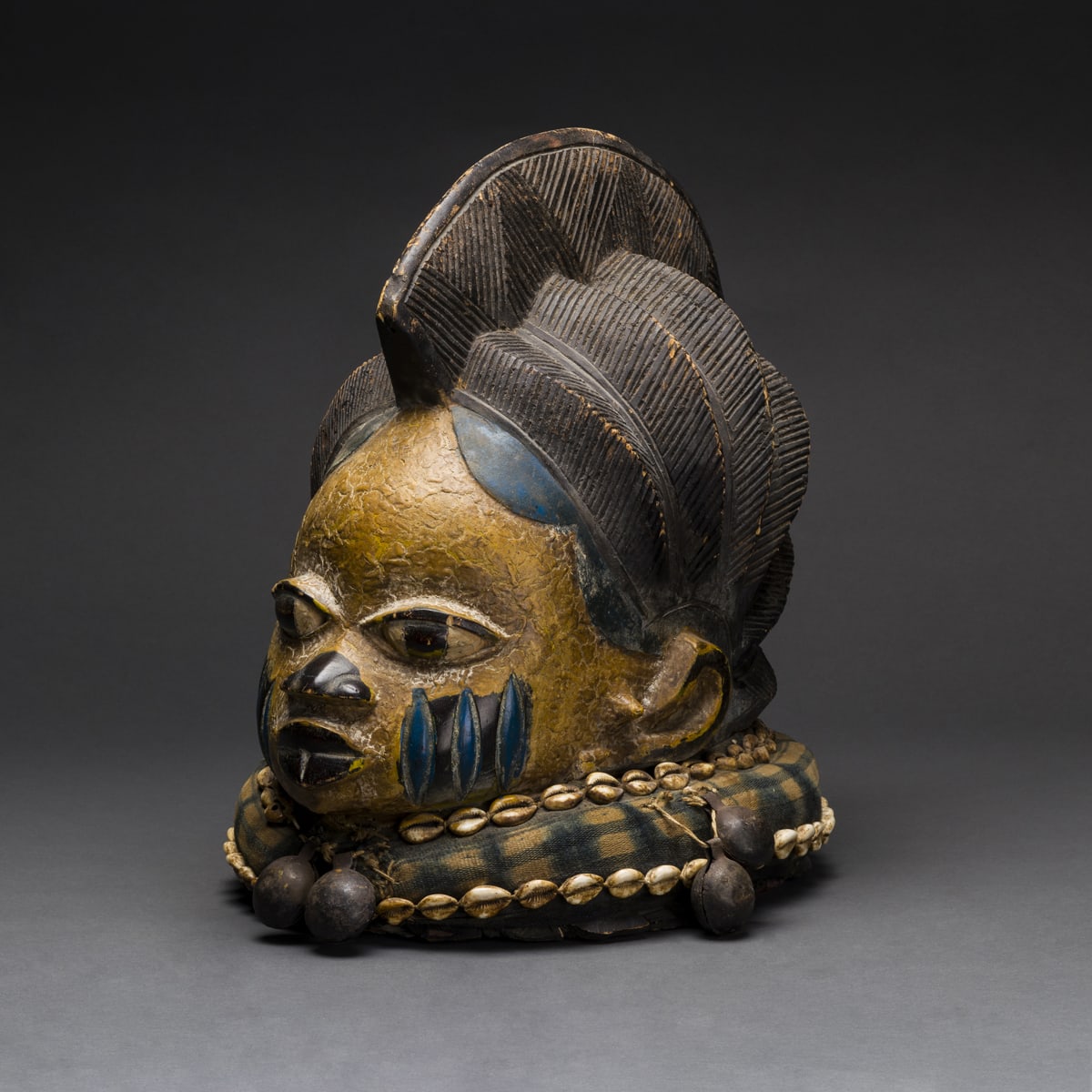Yoruba Wooden Polychrome Gelede Mask, 20th Century CE
Wood, Mixed Media
26.7 x 41.9 cm
10 1/2 x 16 1/2 in
10 1/2 x 16 1/2 in
PF.5405 (LSO)
Further images
This remarkable piece is an exceptional “gelede” mask from the Yoruba of Nigeria. It is designed along traditional lines, as a large helmet mask with a high coiffure and a...
This remarkable piece is an exceptional “gelede” mask from the Yoruba of Nigeria. It is designed along traditional lines, as a large helmet mask with a high coiffure and a naturalistic human face. However, the face is exceptionally serene and well-modelled, with very bright and contrasting colouring of the face, eyes and triple vertical scars that adorn each cheek. The hair is modelled as a low, domed transverse crest, halved in the midline by a central, longitudinal crest; both are decorated with incised decoration. The base of the piece is lined with a large, cushioned pad of textile, decorated with cowrie shells and metal bells. This is an unusual detail for this form of mask, and the implications are of wealth as cowries were used as money in this area of West Africa.
This mask is intimately associated with rituals performed by men’s societies within the Yoruba polity. Specifically, Gelede is intended to honour the spiritual aspects of femininity, and to prevent this from becoming destructive to the society to which they belong. Angered female spirits (Aje) may destroy entire communities; for this reason, they are placated by dancing performances so that their power is directed towards the benefits of the group. Each village and area had distinctive patterns of Gelede masks that reflect some facet of their social organisation or mythology. The mask would have been worn with a large cloth costume that would have covered the masquerade dancer and concealed their identity.
The Yoruba are a Central Nigerian tribal group, originally descended from a Hausa migration from the northeast in about 900 AD. A small kingdom – Ile Ife – was founded by Oduduwa, followed by great sociopolitical expansion into Southwest Nigeria, Benin, and Togo. The influence of the city was felt far beyond these boundaries, however, and many smaller political entities were held under its sway. Communities were presided over by the Oba (king) and various senates (Ogboni), and councils made up of guild leaders, merchants and the lesser aristocracy (related to the Oba). The Yoruba have an exceptionally rich and diverse mythology, history and religious context, all of which are directly linked to their artistic output; Yoruba society, this grouped heritage is known as the Itan, of which this striking mask is a part.
It is possible that further research could determine more specifics about this piece. However, whatever its specific origin, it is a remarkably well-rendered and patinated piece that would grace any collection or sophisticated domestic setting.
This mask is intimately associated with rituals performed by men’s societies within the Yoruba polity. Specifically, Gelede is intended to honour the spiritual aspects of femininity, and to prevent this from becoming destructive to the society to which they belong. Angered female spirits (Aje) may destroy entire communities; for this reason, they are placated by dancing performances so that their power is directed towards the benefits of the group. Each village and area had distinctive patterns of Gelede masks that reflect some facet of their social organisation or mythology. The mask would have been worn with a large cloth costume that would have covered the masquerade dancer and concealed their identity.
The Yoruba are a Central Nigerian tribal group, originally descended from a Hausa migration from the northeast in about 900 AD. A small kingdom – Ile Ife – was founded by Oduduwa, followed by great sociopolitical expansion into Southwest Nigeria, Benin, and Togo. The influence of the city was felt far beyond these boundaries, however, and many smaller political entities were held under its sway. Communities were presided over by the Oba (king) and various senates (Ogboni), and councils made up of guild leaders, merchants and the lesser aristocracy (related to the Oba). The Yoruba have an exceptionally rich and diverse mythology, history and religious context, all of which are directly linked to their artistic output; Yoruba society, this grouped heritage is known as the Itan, of which this striking mask is a part.
It is possible that further research could determine more specifics about this piece. However, whatever its specific origin, it is a remarkably well-rendered and patinated piece that would grace any collection or sophisticated domestic setting.
Literature
V27





